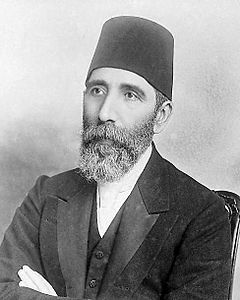Hüseyin Hilmi Pasha
|
Hüseyin Hilmi Pasha |
|
|---|---|
 |
|
| Grand Vizier of the Ottoman Empire | |
|
In office 14 February 1909 – 13 April 1909 |
|
| Monarch | Abdülhamid II |
| Preceded by | Kâmil Pasha |
| Succeeded by | Ahmed Tevfik Pasha |
|
In office 5 May 1909 – 12 January 1910 |
|
| Monarch | Mehmet V Reşad |
| Preceded by | Ahmed Tevfik Pasha |
| Succeeded by | Ibrahim Hakki Pasha |
| Minister of the Interior | |
|
In office 1908–1909 |
|
| Inspectorate-General of Macedonia | |
|
In office 1902–1908 |
|
| Ambassador to Austria-Hungary | |
|
In office 1912–1918 |
|
| Personal details | |
| Born |
1 April 1855 Lesbos, Ottoman Empire |
| Died | 1922 Vienna, Austria |
| Nationality | Ottoman |
| Religion | Islam |
Hüseyin Hilmi Pasha (Ottoman Turkish: حسین حلمی پاشا, also spelled Hussein Hilmi Pasha) (1 April 1855 – 1922) was an Ottoman statesman of Greek descent and twice Grand Vizier of the Ottoman Empire around the time of the Second Constitutional Era. He was also one-time president of the Turkish Red Crescent. Hüseyin Hilmi was one of the most successful Ottoman administrators in the explosive Balkans of the early 20th century, becoming the Ottoman Inspectorate-General of Macedonia from 1902 to 1908, Minister of the Interior from 1908 to 1909, and ambassador to Austria-Hungary from 1912 to 1918.
Hüseyin Hilmi was born in 1855 in Lesbos to a family of Greek ancestry who had formerly converted to Islam. He did his primary studies in Lesbos and learned fluent French at an early age. He started out as a clerk in the Ottoman state structure and gradually climbed the ladder of the hierarchy, becoming the governor of Adana in 1897 and of Yemen in 1902. That same year in 1902, he was appointed Inspectorate-General with responsibility over virtually all of the Balkan territories of the Ottoman Empire at the time, namely the vilayets of Salonica, Kosovo and Manastir.
...
Wikipedia
